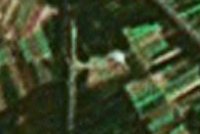 |
| Aerial View |
The death camp in Treblinka was located in the northeastern region of the
Generalgouvernement.
The camp was erected in a sparsely populated area near
Malkinia Gorna, a
junction on the
Warsaw - Bialystok railway line, 4 km northwest of Treblinka
village and its railway halt, and about three km westnorthwest of
Wolka Okraglit village.
The site chosen was heavily wooded and well hidden from view.
In 1941,
a penal camp known as
Treblinka I had been established nearby.
Poles and Jews were imprisoned in this penal camp, working in quarries from which they extracted
materials used in the construction of fortifications on the German – Soviet border.
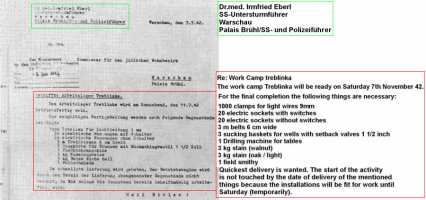 |
| Letter from Eberl, 1st Camp Commander |
The extermination camp was established as part of
Aktion Reinhard;
work on it began in late
May / early June 1942. The contractors were the German construction
firms
Schönbronn (
Leipzig) and
Schmidt-Münstermann.
The barbed wire was delivered by the
Deutsche Seil- und Drahtfabrik
(
Freiberg in Saxony)
[
letter //
waybill].
Treblinka was ready to receive transports from
22 July 1942. Jews from
Warsaw and neighbouring towns, as well as inmates from Treblinka I, were used
to complete the construction. In charge of the building work was
SS Hauptsturmführer
Richard Thomalla, the
Aktion Reinhard construction expert.
Rudolf Höss,
Auschwitz commandant,
visited Treblinka in
spring 1942.
The witness
Lucjan Puchala recalled:
"
Initially we did not know the purpose of building the branch track, and it was
only at the end of the job that I found out from the conversations among Germans that the track was to lead to
a camp for Jews. The work took 2 weeks, and it was completed on 15 June 1942. Parallel to the
construction of the track, earthworks continued.
The SS men and Ukrainians supervising the work killed a few dozen people every day. So that when I looked
from the place where I worked to the place where the Jews worked, the field was covered with corpses.
The imported workers were used to dig deep ditches and to build various barracks. In particular, I know that
a building was built of bricks and concrete, which as I learned later, contained people –
extermination chambers."
 |
| The Platform |
The camp's first commander was the Austrian
SS-Obersturmführer
Irmfried Eberl who had served in
Bernburg, one of six
euthanasia killing centres. In
August 1942
he was replaced by
SS-Obersturmführer Franz Stangl, the former
commander of the
Sobibor death camp.
20-30 German and Austrian SS men (most of whom had served in the euthanasia programme) were assisted by
90-120 Ukrainian guards. Some of the Ukrainians were given other duties, including the operation of the
gas chambers. Amongst these were the infamous
Ivan Marchenko and the
lesser-known
Nikolay Shaleyev. Most of the Ukrainians were Soviet
prisoners of war, who had volunteered to serve the Germans and had been enlisted and trained for their
duties at the
Trawniki camp. Some of them were of German extraction, the so-called
Volksdeutsche, who were appointed platoon or squad commanders in the main.
Between 700-1,000 Jewish inmates performed the manual labour, including work that was part of the
extermination process. In addition, they attended to the personal needs of the SS staff.
Groups of Jewish specialists were employed on construction work, which even continued during the
extermination activities. Inmates were also employed in cutting pine branches for use as camouflage for
the barbed wire fences. The prisoners were selected for labour from incoming transports. After some days
they were killed, and replaced by new arrivals.
In
September 1942 Stangl introduced
a permanent command of Jewish prisoners. Some had to unload the wagons ("Station Command"), others worked
at the "Undressing Square", the "Sorting Square", the gas chambers and at the mass graves.
At
Christmas 1942,
Stangl ordered the
construction of a fake railway station: A clock with painted numerals permanently indicating 6 o'clock,
ticket windows and various timetables and arrows (including some indicating train connections "To
Warsaw", "To
Wolkowice" and "To
Bialystok"), were painted on the facade of the sorting barracks. The purpose of this
was to lull the arriving victims into believing that they had actually arrived at a transit camp. To make
the SS living quarters as pleasant as possible, a zoo and a beer garden were also constructed.
In addition to the camp structures, a branch railway track was created, leading from the camp to the
nearby railway station, led by the station master
Franciszek Zabecki. Huge pits, to be used as mass graves, were dug inside the camp.
The camp was laid out in an irregular rectangle 400 m wide by 600 m long, surrounded by a barbed wire
fence with intertwined tree branches to block any view into the camp from outside. A second outer fence
consisting of barbed wire and anti-tank obstacles (Spanish Horses) was also constructed at a later stage.
Watchtowers (8 m high) were placed at each of the four corners of the camp, and additional towers were built
in the extermination area.
The camp was divided into three zones of nearly equal size; the SS and Ukrainian living area, the reception
area (
Auffanglager) and the extermination area (
Totenlager). The living and reception areas were
called the "Lower Camp", whilst the extermination area was known as the "Upper Camp".
The living area was in the northwest section of the camp. It comprised the living quarters for the
German SS and Ukrainian personnel as well as other administration buildings, which included offices,
an infirmary, stores and workshops. The entrance gate to the camp was in the northwest section, near the
railway line. A more elaborate gate was later built, consisting of two wooden pillars, each decorated with
a metal flower and crowned by a small roof which rested on the pillars. At night floodlights lit the entrance.
Ukrainians and SS men were posted at the gate and at the guardhouse. At the entrance a sign read
"
SS Sonderkommando Treblinka".
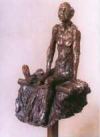 |
| Disabled Man |
A 100 x 100 m square was separated from the rest of the camp by a barbed wire fence. It contained three
barracks forming a "U" shape. Here the Jewish prisoners who worked in the "Lower Camp" spent their nights.
At the far side of the roll call area of this section was the latrine, covered by a straw roof.
The
transports arrived at the reception area in the southwest
section of the camp. This area included the railway track and station platform with the ramp (200 m) and
the fake station building. At the rail entrance on the spur was a wooden gate wrapped in barbed wire intertwined
with tree branches.
The
Lazarett, a small execution site, was also in the reception area.
Those too ill or too weak to continue to the gas chambers, together with unaccompanied children and those who
had been injured in transit, were taken to a fenced-in area with a small wooden building, from which flew a Red
Cross flag. After undressing in the "waiting room" they were shot in the neck and thrown into a pit in which a
fire constantly burned.
Alongside the ramp were two large barracks where the victims' belongings were sorted and stored. North of
these storerooms was the "Station Square". East of this section was a fenced-in area called "Undressing Square",
(
Entkleidungsplatz). At this place the men were separated from the women and children. Two large barracks
were situated here: the northern barrack, utilised by the women to undress and for the cutting of their hair,
and the southern barrack, used in the early phase of the camp's existence for male prisoners' sleeping quarters.
This latter barrack was later used as a storage depot for goods. Male victims undressed in the open air between
the barracks.
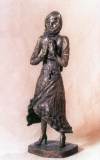 |
| Insane Girl |
The extermination area (approximately 200 x 250 m) where the mass murders were carried out, was in the
southeastern part of the camp. This area was completely isolated from the rest of the camp by a barbed
wire fence camouflaged with tree branches, as well as by high earth mounds, all of which prevented observation
from the outside. The gas chambers were located inside the extermination area in a long brick building.
During the camp's initial phase there were three
gas chambers, similar to the
first gas chambers constructed at
Sobibor. A room attached to the building
contained a
motor, which introduced the poisonous carbon monoxide gas through pipes into
the chambers. It also contained a generator which supplied the electricity to the entire camp.
 |
| Carrying Corpses |
East of the gas chambers and close by them were huge ditches for burying the corpses. A number of these
ditches were approximately 50 m long, 25 m wide and 10 m deep. They were dug by an excavator brought from the
quarry at the Treblinka I work camp.
Initially the bodies were brought from the gas chambers to the ditches by trolleys pushed by the
Sonderkommando
on a narrow-gauge railway. However, this system proved to be impractical and was replaced by the carrying
of corpses on stretchers.
Southeast of the gas chambers, two combined barracks enclosed by a barbed wire fence were erected for
the
Sonderkommando, The barracks included a kitchen, a toilet and later a laundry. A watchtower and a
guardroom were built in the centre of the extermination area.
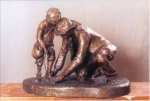 |
| Schuhe runter! |
The "Undressing Square" in the "Lower Camp" was connected to the extermination area by the "Tube". This
pathway, 80-90 m long and approximately 4 m wide, was enclosed with 2 m high camouflaged barbed wire fences.
The Germans called it
Himmelfahrtstraße ("The Road to Heaven"). It commenced behind the women's
undressing barrack and continued east and then south to the gas chambers. The naked Jews were driven along this
path to the building containing the gas chambers.
The incoming deportation trains generally consisted of 50-60 cattle wagons containing six to seven thousand
people in total. After passing through
Malkinia Gorna junction, the trains
crossed the Bug river and came to a halt at Treblinka village station.
Each transport was divided into sections of twenty wagons, which were pushed by a locomotive onto the siding
leading to the camp. The remaining wagons waited at the station. As each section of the transport was about
to enter the camp, Ukrainian and SS men took up positions on the camp railway platform and in the reception
area. When the wagons stopped, the doors were opened one at a time by the "Station Command" (
Kommando Blau)
and the SS men ordered the Jews to leave the wagons.
Oscar Strawczynski:
"
We run out as fast as we can to avoid the whips lashing overhead, and find
ourselves on a long, narrow platform, crowded to capacity. All familiar faces - neighbours and acquaintances.
The dust so tremendous, it obscures the sunlight. A smell of charred flesh stifles the breath. Unwittingly, I catch
a glimpse of the mountains of clothing, shoes, bedding and all kinds of wares that can be seen over the fence.
But there is no time to think... The dense mass of people is pushed toward and jammed through a gate..."
An SS officer then announced to the arrivals that they had arrived at a transit camp from which they would
be sent on to various labour camps, but that first they had to take a shower for hygienic reasons, and to have
their clothes disinfected. Any money and valuables in their possessions were to be handed over for safekeeping
and would be returned to them after they had showered. Following this announcement, the Jews were ordered to
the "Deportation Square".
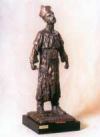 |
| Scheißmeister |
At the entrance to the "Undressing Square", the men were ordered to the right for undressing, and women and
children to the left. Supervised by the "Red Command", this had always to be done at a running pace and was
accompanied by shouting and beating by the guards. Commencing in
autumn 1942,
the women’s hair was shorn behind a partition at the end of the undressing barrack. Afterwards the naked victims
entered the "tube" that led to the gas chambers. Some sources suggest that women and children were gassed first,
whilst the naked men had to wait at the "Undressing Square". Other sources propose that the men were gassed
first. It is possible that the first group to be gassed was dependant on the nature of the transport.
Oscar Strawczynski:
"
But there, on that sorrowful Transport Square, there is no time for tears or feelings. I
scarcely have time to hand my wife the carefully hidden blanket for the children. A brutal hand grips my shoulder
and I am hurled to the other side of the Square. I manage to stay with my gentle father. The place is packed with
people. On one side are women with small children, on the opposite side, men, forced to kneel. In the middle there
are SS men, Ukrainians with weapons in their hands as well as a group of about forty men with red
armbands. These are Jews - the detachment of "Reds". In Treblinka slang they are called
"Chevra Kedisha" (Society for Last Rites).
Most prominent among all in the Square is a German officer, a stout man with a short beard, mounted on
a beautiful brown horse. He moves haughtily on his horse, in the middle of the Square.
At a certain point he turns toward the kneeling men and shouts: "Craftsmen out!" A number of men step out.
Most of them however, are sent back. Only a few are stood aside, where an SS man makes a further
selection, and groups the remaining men in threes. I am kneeling beside my father. My mind is completely blank.
No feeling not a thought. I do not even say a single word to my father."
Once the victims were locked in the gas chambers, the motors were started and the carbon monoxide
gas was pumped in. Within 20 - 30 minutes, all of the victims were dead.
Their bodies were removed from the chambers and taken to the burial or cremation ditches. In the initial
phase, a section of twenty wagons containing 2,000-3,000 people could be liquidated within 3-4 hours. Later
the Germans "gained experience" and reduced the duration of the killing process to an hour and a half.
Even as the first batch of Jews was being murdered, the railway wagons in which they had been transported
were cleared and cleaned. Some 50 prisoners undertook this task. Then the wagons were pulled out of the camp
to make room for the next section, with its human cargo.
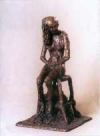 |
| Young Girl |
 |
| Naked Women |
At this time, another team of approximately 50 prisoners collected the clothes and goods that had been kept
in the "Undressing Square" and transferred them to the "Sorting Square". Here a "Sorting Command" searched the
belongings for money or valuables and sorted the clothes. This command was also responsible for removing the
Jewish stars from the clothing, and destroying identity cards and other documents the Germans considered to be
of no value. Once sorted, the victim's possessions
were forwarded to the
SS warehouses in
Lublin.
200-300 prisoners, the "Special Command" (
Sonderkommando), was employed in the extermination area on such
tasks as the removal of the corpses from the gas chambers, cleaning the chambers, extraction of the victims'
gold teeth and the burying of the bodies. From
winter 1942/43 corpses were
cremated by the
Sonderkommando instead of being buried.
 |
| Collecting Bottles |
 |
| Sorting Valuables |
As at
Belzec and
Sobibor, the Germans
soon realised that the available number of gas chambers was inadequate to deal with the volume of Jews to be
transported for extermination.
Between early
September 1942 and the beginning of
October 1942, they therefore decided to build the
"
New Gas Chambers" with ten killing rooms.
In order to obtain the bricks necessary for the construction of the new gas chambers, the old glass factory chimney
at
Malkinia was
demolished by the camp's construction expert,
Erwin Lambert.
Heinrich Arthur Matthes was chief officer of the "Upper Camp", assisted
by
Gustav Münzberger, Fritz Schmidt and the
Ukrainians Marchenko and Shaleyev.
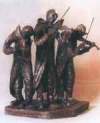 |
| The Orchestra |
The extermination programme at Treblinka began on
23 July 1942. The first transports
came
from the Warsaw Ghetto. By
21 September 1942
254,000 Jews from the
Warsaw Ghetto and 112,000 from other places in the
Warsaw district had been murdered in Treblinka. Among the victims was
Janusz Korczak, the noted director of a children’s orphanage in
Warsaw.
By the
winter of 1942-43, 337,000 Jews from the
Radom
district had been killed, as well as 35,000 from the
Lublin district. In total,
an estimated 738,000 Jews from the
Generalgouvernement and more than 107,000 from the
Bialystok district were slaughtered between
July 1942
and
April 1943, always accompanied by the
camp orchestra.
Jews from outside Poland also perished at Treblinka: 7,000 Jews from Slovakia, (who had first been deported to
ghettos in the
Generalgouvernement) were murdered in
summer and autumn 1942.
Between
5 October and 25 October 1942, five transports brought 8,000 Jews from
Terezin (Theresienstadt). From Greece over 4,000 Jews
(who had first been deported from their homes in
Thrace to Bulgaria) arrived in the latter half
of
March 1943.
7,000 Macedonian Jews were murdered between
March 1943 and April 1943. At least one
transport of 2,800 Jews was dispatched from
Salonika at the end of
March 1943. 2,000 Romanies were also murdered in Treblinka.
The extermination programme continued until
April 1943, after which only a few
isolated transports arrived.
Following the visit of
Reichsführer SS
Heinrich Himmler to Treblinka in late
February
or early
March 1943, the order was issued to cremate the bodies. The mass graves were
opened and the corpses were exhumed and burned on huge cremation grids, constructed from railway tracks
(
"Aktion 1005").
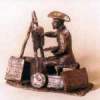 |
| The Painter |
During
spring 1943, a savage typhus epidemic ravaged the Jewish prisoners. Hundreds
of them were executed at the
Lazarett by
August Miete and
Willi Mentz.
Several individual attempts to resist occurred; for example, the killing of SS man
Max Biala by
Meir Berliner on
11 September 1942, but it was not until the early months of
1943 that a resistance group was formed. This group included
Galewski, Dr Julian Chorazycki, Zelo Bloch, Zvi Kurland, Rudolf Mazarek and
Dr Leichert. Not all of the group survived the uprising; many were to die heroically.
 |
| Revolt |
When the cremation of the bodies was nearing completion and it was clear that the camp and the prisoners were
about to be liquidated, the leaders of the underground movement resolved that
the uprising could not be postponed any longer. A date and time were
fixed - 5 p.m. on
2 August 1943.
Initially the uprising went according to plan. With a copied key the armoury was opened. Weapons were removed
and handed to the members of the resistance.
Shortly before the time that the uprising was scheduled to commence, some of the SS-men had decided to bathe
in the nearby
Bug River, thereby weakening the garrison. Because of this, and in order to
ensure that the uprising was not compromised, the rebels had no option but to start the revolt earlier than planned.
The rebels possessing stolen weapons opened fire on the camp guards. The petrol station exploded and wooden barracks were
set ablaze. The gas chambers were not damaged. A mass of prisoners now tried to storm the fences in an attempt
to escape from the camp. They were fired at by the guards in the watchtowers. Most of those attempting to escape
were shot as they became entangled in the barbed wire that was intertwined with the anti-tank traps.
 |
| Escape |
Those that did escape were pursued by the local police and security forces, including guards from Treblinka I.
1,000 inmates were still alive when the uprising on
2 August 1943 took place.
Of these, only 200 managed to break out. About 60 of the escapees were still alive at the end of the war to tell
the world about the horror of Treblinka.
A number of survivors testified at the post-war trials of
Josef Hirtreiter
in the
1950's. The major trial of Treblinka SS-men took place in
1964/65; the trial of commandant
Franz Stangl in
1970.
Of the prisoners who remained in the camp after the uprising, some were killed on the spot. The rest were forced
to demolish the remaining structures and obliterate all traces of the camp's murderous activities.
Since the gas chambers were still operational after the revolt, the last victims were gassed on
21 August 1943. These were transports from
Bialystok and had the numbers PJ 207 and PJ 208.
 |
| After the War |
When this final gassing was completed, the camp area was ploughed over and trees were planted. The camp was
turned into a farm. A Ukrainian guard, a certain
Streibel, was settled there,
in order to give the impression that nothing untoward
had happened at the camp site, and to prevent the local
population from unearthing any remaining valuables. After he left the site, the local population descended
on the camp site, looking for gold and other valuables. Whilst doing this they unearthed parts of decomposed bodies.
The remaining Jewish prisoners, who had been forced to dismantle the camp, were transferred to the
Sobibor death camp on
20 October 1943, via
Siedlce and
Chelm.
On
17 November 1943, the last transport departed, carrying equipment from the camp.
Parts of the barracks
were sent to the
Forced Labour Camp Dorohucza
near
Trawniki.
It is estimated that a minimum of between 700,000 and 800,000 Jews lost their lives in Treblinka. Most recent
research suggests a figure at or beyond the upper limit of this range.
Wladyslaw Szlengel: Treblinka
Map: Sir Martin Gilbert
Sources:
Encyclopaedia of The Holocaust
Arad:
Belzec, Sobibor and Treblinka
Hilberg:
Sonderzüge nach Auschwitz
Donat:
The Death Camp Treblinka
Sereny:
Into that Darkness
Willenberg:
Surviving Treblinka
© ARC 2006



























